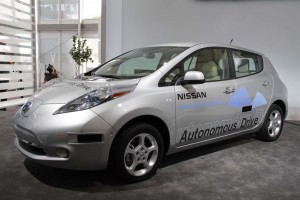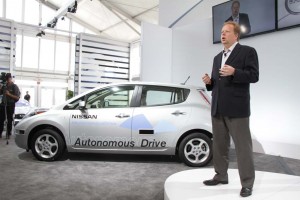Nissan will put a fully autonomous vehicle into production by 2020, the automaker announced Tuesday during a California event designed to show off its latest products and technologies.
Hands-off driving has become the Holy Grail of the auto industry, a concept that proponents claim could not only curb crashes, injuries and fatalities but also improve traffic flow, reduce energy consumption and limit CO2 emissions.
Describing hands-off technology as “the next frontier for the auto industry,” Nissan’s global product chief, Executive Vice President Andy Palmer declared, “We will be ready to bring a readily affordable, fully affordable autonomous vehicle to the market by 2020.”

A prototype self-driving Nissan Leaf. Notice the camera slits below the headlights and on the rear doors.
Virtually every major automaker has been working on autonomous technology, as is Silicon Valley tech giant Google. And at a recent industry confab, a number of experts suggested the technology could begin rolling into showrooms between 2020 and 2025, though other observers questioned whether the industry could move that fast.
Indeed, coming up with the right mix of sensors, cameras, mapping data and software is only part of the problem, said Nissan’s Palmer in a follow-up interview with TheDetroitBureau.com. He cautioned that the right infrastructure and, in particular, the right regulatory environment will be necessary. Indeed, he and other proponents caution that the litigious nature of the U.S. might encourage manufacturers like Nissan to steer the technology to other markets, at least initially.
“We need regulations that support a company for bringing out this type of technology,” Palmer stressed.
Autonomous vehicles have long been the stuff of science fiction, but recent breakthroughs in onboard cameras, radar and sonar sensors, computing power and speed, and software now appear to have reached a point where hands-off driving can move from the test track to public roads. Indeed, several states, including Nevada and California, have set up licensing regulations permitting pioneers like Google to test their prototypes on the street.
And some of the underlying technologies have already begun to migrate into production vehicles. Nissan’s Infiniti brand recently launched its new Q50 sedan, the world’s first production vehicle equipped with a steer-by-wire system where the steering wheel and front tires are linked electronically, rather than mechanically. That not only permits the vehicle to steer more aggressively but also allows a new lane-following system to hold its position on a highway, even though moderate turns.
(For a review of the new Infiniti Q50, Click Here.)
The new 2014 Mercedes-Benz S-Class, meanwhile, offers what the German maker describes as a “sensor fusion,” bringing together various systems designed to detect obstacles, traffic and even read road signs. It can, for example, come to a complete stop if a pedestrian walks in front of the big sedan.
While a motorist can’t simply hand off driving duties, “It’s paving the way towards (fully) autonomous driving,” Mercedes’ brand boss and parent Daimler AG chairman Dieter Zetsche suggested at the S-Class preview.
(For more on the 2014 Mercedes S-Class, Click Here.)
The potential benefits are huge, according to proponents.
“Autonomous driving will help reduce accidents and improve safety,” potentially reaching a point of zero fatalities, asserted Nissan’s Palmer. It could also permit more efficient use of public roads, especially in traffic-snarled cities, with an added benefit of reduced energy consumption if vehicles have to stop-and-go less frequently. Palmer also cited forecasts that widespread use of autonomous vehicles could reduce by as much as 300 million tons a year the CO2 emissions produced by automobiles worldwide.
Nissan officials provided few details about their production plans for 2020 though, significantly, they were demonstrating their prototype autonomous technology on a modified version of the Nissan Leaf battery-electric vehicle. Meanwhile, Palmer noted that the Japanese maker’s longer-term plans call for offering autonomous technology, at least as an option, “across our line-up within two vehicle generations.”
While he admitted in a later discussion that this goal is an ambitious stretch, it could mean broad availability by late in the 2020s. Nissan officials added that they would be surprised if other manufacturers didn’t respond to their announcement by laying out plans of their own for launching autonomous vehicle production.
Where — and how quickly — the technology appears could depend on how lawmakers and regulators in the U.S. and other parts of the world respond.
(UK could take lead in driverless technology. Click Here to find out why.)


Okey dokey.
Too many things must go right for this to happen. 6 years is not a long time.
But you gotta give them props for having a man on the moon goal